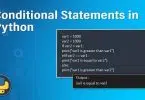In this post, you will learn the Feature, Uses, and Advantages of Array in Python. Before we get started, if you want to Tuple in the python program, please go through the following article: TUPLE in Python.
What is Python Array?
A Python Array is a common type of data structure wherein all elements must be of the same data type. In Python programming, an array can be handled by the “array” module. If you create arrays using the array module, elements of the array must be of the same numeric type.
When to use Array in Python?
Python arrays are used when you need to use many variables which are of the same type. It can also be used to store a collection of data. The arrays are especially useful when you have to process the data dynamically. Python arrays are much faster than list as it uses less memory.
Syntax to Create an Array in Python
You can declare an array in Python while initializing it using the following syntax.
|
1 |
arrayName = array.array(type code for data type, [array,items]) |
The following image explains the syntax.
- Identifier: specify a name like usually, you do for variables
- Module: Python has a special module for creating arrays, called “array” – you must import it before using it
- Method: the array module has a method for initializing the array. It takes two arguments, type code, and elements.
- Type Code: specify the data type using the type codes available (see list below)
- Elements: specify the array elements within the square brackets, for example [130,450,103]
How to create an Array in Python?
In python we use the following syntax to create arrays:
|
1 |
Class array.array(type code[,initializer]) |
For Example
|
1 2 |
import array as myarray abc = myarray.array('d', [2.5, 4.9, 6.7]) |
The above code creates an array having an integer type. The letter’ is a type code. The following tables show the type codes:
| Type code | Python type | C Type | Min size(bytes) |
|---|---|---|---|
| ‘u’ | Unicode character | Py_UNICODE | 2 |
| ‘b’ | Int | Signed char | 1 |
| ‘B’ | Int | Unsigned char | 1 |
| ‘h’ | Int | Signed short | 2 |
| ‘l’ | Int | Signed long | 4 |
| ‘L’ | Int | Unsigned long | 4 |
| ‘q’ | Int | Signed long long | 8 |
| ‘Q’ | Int | Unsigned long long | 8 |
| ‘H’ | Int | Unsigned short | 2 |
| ‘f’ | Float | Float | 4 |
| ‘d’ | Float | Double | 8 |
| ‘i’ | Int | Signed int | 2 |
| ‘I’ | Int | Unsigned int | 2 |
How to access array elements?
You can access any array item by using its index. The syntax is
|
1 |
arrayName[indexNum] |
For example,
|
1 2 3 |
import array balance = array.array('i', [300,200,100]) print(balance[1]) |
Output:
|
1 |
200 |
The following image illustrates the basic concept of accessing array items by their index. Here, we have accessed the second value of the array using its index, which is 1. The output of this will be 200, which is basically the second value of the balanced array. The array index starts with 0. You can also access the last element of an array using the -1 index.
Example:
|
1 2 3 4 |
import array as myarray abc = myarray.array('d', [2.5, 4.9, 6.7]) print("Array first element is:",abc[0]) print("Array last element is:",abc[-1]) |
Output:
|
1 2 |
Array first element is: 2.5 Array last element is: 6.7 |
You can also access elements by using the ‘:’ operator.
Example:
|
1 2 3 4 |
import array as myarray abc= myarray.array('q',[3,9,6,5,20,13,19,22,30,25]) print(abc[1:4]) print(abc[7:10]) |
Output:
|
1 2 |
array('q', [9, 6, 5]) array('q', [22, 30, 25]) |
This operation is called a slicing operation.
How to insert elements?
Python array insert operation enables you to insert one or more items into an array at the beginning, end, or any given index of the array. This method expects two arguments index and value. The syntax is
|
1 |
arrayName.insert(index, value) |
Example:
Let’s add a new value right after the second item of the array. Currently, our balance array has three items 300, 200, and 100. Consider the second array item with a value of 200 and index 1. In order to insert the new value right “after” index 1, you need to reference index 2 in your insert method, like this:
|
1 2 3 4 |
import array balance = array.array('i', [300,200,100]) balance.insert(2, 150) print(balance) |
Output:
|
1 |
array('i', [300,200,150,100]) |
Example 2:
|
1 2 3 4 |
import array as myarr a=myarr.array('b',[2,4,6,8,10,12,14,16,18,20]) a.insert(2,56) print(a) |
Output:
|
1 |
array('b', [2, 4, 56, 6, 8, 10, 12, 14, 16, 18, 20]) |
How to modify elements?
In Python, arrays are mutable. They can be modified by the following syntax:
|
1 |
Object_name[index]=value; |
Example:
|
1 2 3 4 |
import array as myarr a=myarr.array('b',[3,6,4,8,10,12,14,16,18,20]) a[0]=99 print(a) |
Output:
|
1 |
array('b', [99, 6, 4, 8, 10, 12, 14, 16, 18, 20]) |
We can also perform concatenation operations on arrays.
Example:
|
1 2 3 4 5 6 |
import array as myarr first = myarr.array('b', [4, 6, 8]) second = myarr.array('b', [9, 12, 15]) numbers = myarr.array('b') numbers = first + second print(numbers) |
Output:
|
1 |
array('b', [4, 6, 8, 9, 12, 15]) |
The above code Concat two variables called “first” and “second”. The result is stored in a variable called “number”. The last line of code is used to print two arrays.
How to pop elements?
In Python, a developer can use an array.pop([a]]) syntax to pop element from array. Example:
|
1 2 3 4 |
import array as myarr first = myarr.array('b', [20, 25, 30]) first.pop(2) print(first) |
Output:
|
1 |
array('b', [20, 25]) |
You can also use the ‘del’ statement of Python.
Example
|
1 2 3 4 |
import array as myarr no = myarr.array('b', [10, 4, 5, 5, 7]) del no[4] print(no) |
Output:
|
1 |
array('b', [10, 4, 5, 5]) |
How to delete elements?
With this operation, you can delete one item from an array by value. This method accepts only one argument, value. After running this method, the array items are re-arranged, and indices are re-assigned. The syntax is
|
1 |
arrayName.remove(value) |
Example:
Let’s remove the value of “3” from the array
|
1 2 3 4 |
import array as myarray first = myarray.array('b', [2, 3, 4]) first.remove(3) print(first) |
Output:
|
1 |
array('b', [2, 4]) |
How to Search and get the index of a value in an Array
With this operation, you can search for an item in an array based on its value. This method accepts only one argument, value. It is a non-destructive method, which means it does not affect the array values. The syntax is
|
1 |
arrayName.index(value) |
Example:
Let’s find the value of “3” in the array. This method returns the index of the searched value.
|
1 2 3 |
import array as myarray number = myarray.array('b', [2, 3, 4, 5, 6]) print(number.index(3)) |
Output:
|
1 |
1 |
This operation will return the index of the first occurrence of the mentioned element.
How to Reverse an Array?
This operation will reverse the entire array. Syntax: array.reverse()
|
1 2 3 4 |
import array as myarray number = myarray.array('b', [1,2, 3]) number.reverse() print(number) |
Output:
|
1 |
array('b', [3, 2, 1]) |
Convert array to Unicode
Python array can be converted to Unicode. To fulfill this need, the array must be a type ‘u’; otherwise, you will get “ValueError.”. Example:
|
1 2 3 4 5 |
from array import array p = array('u',[u'\u0050',u'\u0059',u'\u0054',u'\u0048',u'\u004F',u'\u004E']) print(p) q = p.tounicode() print(q) |
Output:
|
1 2 |
array('u', 'PYTHON') PYTHON |
Count the occurrence of a Value in Array
You can also count the occurrence of elements in the array using the array.count(x) syntax. Example:
|
1 2 3 |
import array as myarr number = myarr.array('b', [2, 3, 5, 4,3,3,3]) print(number.count(3)) |
Output:
|
1 |
4 |
Traverse an Array
You can traverse a python array by using loops, like this one:
|
1 2 3 4 |
import array balance = array.array('i', [300,200,100]) for x in balance: print(x) |
Output:
|
1 2 3 |
300 200 100 |






Leave a Comment